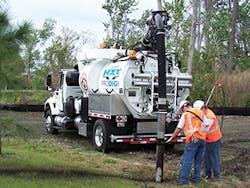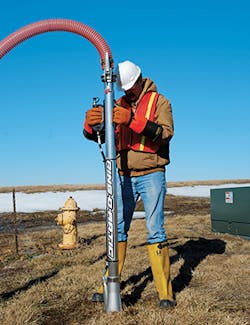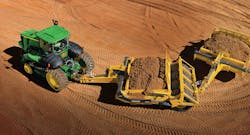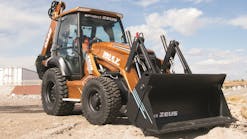A good piece of vacuum excavation equipment in the fleet can make jobs easier, safer, faster, and more efficient. It can help a company cast a wider net for project opportunities.
That’s been the case for Bortec Inc., an Eldridge, IA-based company that installs utilities through horizontal directional drilling. Along with seven employees and part-timers hired for seasonal work, company president Reed Storjohann and his crew utilize vacuum excavation as part of their approach to working on job sites within a 150-mile radius.
“In a small company like mine where you don’t have the manpower, vacuum excavation cuts out a lot of support vehicles, manpower, and time,” notes Storjohann.
The advantage of vacuum excavation in contrast to other excavation methods is that it is non-mechanical, so underground infrastructure such as fiber optics, gas lines, and electrical lines are not contacted mechanically, reducing the risk of damage, says Ben Schmitt, product manager for Vactor Manufacturing.
Each year, the Common Ground Alliance (CGA) provides a report outlining the number and cause of underground strikes, he notes. “According to the report, there is a known utility strike every two minutes. The report also indicates that the top two leading causes of more than 60% of all recorded underground strikes are backhoes and hand tools such as shovels,” says Schmitt.
“Vacuum excavation accounted for less than half a percent of the total number of recorded underground strikes. Vacuum excavation is the only non-destructive method to dig around buried infrastructure safely,” he adds.
The choice between using hydroexcavation or air excavation, however, depends on a variety of factors.
Vacuum excavation is a combination of two non-mechanical sources to excavate soil and can range from small trailer-mounted systems to large truck-mounted equipment, Schmitt points out. “The first source is pressurized water or air, which is used to loosen soil,” he says. “Once the soil is loosened, a powerful vacuum system uses air flow and vacuum to pick up and recover the material.”
The material is then stored in a debris body or hopper to be transported offsite or reused.
Before deciding between air excavation and hydro-excavation, it’s helpful to know the size of a typical application so that the correct sized debris body is selected to complete the work as efficiently as possible, says Schmitt. “Knowing the soil conditions is paramount for selecting the right equipment,” he adds. “Other factors include travel distance to a disposal site, state and local weight restrictions, excavation distance from the unit, and availability of water.”
Hydroexcavation trucks consist of a powerful vacuum system and an onboard water blaster and water tank so anything that can be sprayed, washed down, or vacuumed can be completed with this equipment, says Schmitt.
“In my mind, hydro is the most productive, safest and most economical as compared to large CFM air-only units,” says Brian Metcalf, CEO of Ring-O-Matic. “It takes a tremendous amount of horsepower to drive large blowers and fans to generate enough CFM to be productive.”
Hydroexcavation offers a great deal of versatility, says Tim Van Til, Eastern industrial sales manager for Sewer Equipment of America. “It will work in all sorts of soil conditions where you can be limited with the air in certain soils,” he adds.
Vactor HXX Prodigy
Another benefit of hydroexcavation is that it does not produce the sandblasting effect as does air, reducing the potential for damage to underground utilities, says Schmitt. “Water also is a lubricant, which helps to prolong the life of the excavation equipment by reducing wear on the vacuum hose and other components in the airstream,” he adds.
It is best to use hydroexcavation when the soil types are aggressive, such as soils containing rocks, heavily compacted soils such as clay, and frozen soils and permafrost, notes Mike Selby, inside sales manager for Vac-Con.
Hydroexcavation enables contractors to dig deeper with more precision and have more capacity out of their machines, says Van Til.
Schmitt points out that “water is able to move more material faster and more efficiently. In frozen ground or harder materials, water can be heated with onboard water heaters to aid in cutting through these materials.”
“We often see water being used in clay soils or where more bulk excavation and production potholing is required for spotting utilities during horizontal directional drilling projects,” says Jeff Wage, vice president, McLaughlin. “It’s also common on sites where the vacuum would be used for both potholing and managing drill fluids on the same project.”
Hydroexcavation is best used in areas that are sensitive to utility hits using normal or mechanical digging methods and is the safest way to excavate a job site, notes Metcalf.
“Know what you are excavating,” says Selby. “If the utility is not capable of withstanding direct contact from high pressure water, hydroexcavation is not usable.”
Regarding the use of hydroexcavation equipment, Schmitt points out a wide array of applications exist for utilities, construction companies, and municipalities, including installing light poles, repairing water main breaks, long trenches for burying cable, fiber optic repair, cathodic protection for gas and water lines, pressure testing, hauling fresh water to a job site, towing a trailer, and even window well installation. “Hydroexcavation equipment can often be used for tank, pit, or general cleaning,” he says. “With the onboard high-pressure water pump, hydroexcavators can perform many alternate applications that cannot be completed with pneumatic excavators.”
Air excavation—or pneumatic excavation—allows contractors to locate a utility to verify its location, while also allowing dry backfilling of the hole with the same soil it excavated, says Schmitt, adding that it does not require disposing of wet/muddy slurry of material. “The advantage of air excavation is that air is limitless,” he says. “Onboard compressors generate the required pressure on demand so there is no need to refill water. Air is nonconductive.
“When vacuuming around live electrical wires, pneumatic excavation can be a preferred choice over hydroexcavation,” continues Schmitt. “Air excavation also provides dry spoils that can be returned to the excavation site immediately.”
Vacuum excavation generally uses compressed air to loosen the soil to be excavated, points out Selby. “This works well in loosely compacted soils. Generally, vacuum excavation is used where the utility cannot come in direct contact with water. Other requirements for vacuum excavation are occasions when the material is being returned directly to the area that was excavated and cannot be wet. Also, vacuum excavation should be used in areas where water can cause a chemical reaction with the material.”
Air is often selected for projects where the crew is able to reuse backfill on the job site, says Wage. “While air excavation can be slightly slower than water excavation, it’s often a productive choice when contractors are facing high dumping costs and long distances to dumping sites,” he points out. “Air excavation is beneficial in that a contractor is not bringing in imported soils and hauling off the old, wet soil. Air also can be more productive when working in an urban environment. Ground conditions that are ideal for air excavation include soft soil, dirt or sand.”
Air excavation is not particularly well-suited for harder or frozen soils,” adds Schmitt.
Air excavation is often used for gas service replacement work or with One Call or SUE contractors who are doing pre-work site investigations, says Wage, adding that of late, he has seen increased interest in using air excavation for the placement of power poles.
Ring-O-Matic VIPER
Construction contractors, municipalities and utilities are using air excavation more frequently, and their demand for equipment continues to grow, says Schmitt. “Many applications in the utility segment require exposing the utility, making the repair, and then backfilling the material,” he says. “This can’t be done with hydroexcavation.”
Air excavation is desired in applications where water is not readily available, including drought conditions, industry experts say.
Also, “when working around buried electrical lines or brittle utilities, air excavation is often preferred due to the lower operating pressures,” says Schmitt.
Schmitt adds that the speed of hydroexcavation is too significant to overlook for general potholing, which is why utilities are looking for a machine with both capabilities.
Storjohann has both air and hydroexcavators in his company’s fleet from McLaughlin. He previously had only a hydroexcavator, but found he needed an air one as well, adding an ECO 100XT Air Series unit.
“The main reason for that is when you vacuum with air excavation, you don’t have near the material when you’re done,” he says. “When you add water, you get twice the material and you have to find a place to dump, which is usually never convenient to the work site.
Ring-O-Matic combo jetter
“You don’t fill up near as fast and you also can return your spoils right there on the ground and tamp them back in,” he adds. “You don’t have to bring in a support vehicle that has sand or backfill material. You save so much time and money.”
While Storjohann prefers to use the air excavator, there are times he likes the option of using a hydroexcavator. “When you get into the deeper depths with loamy wet clay and the water table, air doesn’t work as well in the moisture,” he says. “It tends to plug a little more. Air excavation definitely works better with dryer soils, which are usually at a shallow depth.”
The techniques for using both air and hydroexcavators are similar, says Van Til. “Water is more precise,” he says. “Air is more like a rupture of the earth, so the techniques are a little bit different, but the basic principles are the same.”
Those using hydroexcavation during freezing temperatures need to ensure they winterize the trucks, Van Til points out, adding “anytime you’re using water on a machine, cold weather is not going to be your friend if you leave water in it overnight.”
With air, operators should focus on short hose lengths and on limiting obstructions, says Wage. “They should know how to keep the inside of the hose dry and how to keep materials from sticking or catching on the inside of the hose,” he says. “Often air vac operators carry a small bat or club to hit the suction hose and knock sticking material off the walls of the hose from time to time. Depending on soil types, this can help avoid full-blown clogs.”
Air excavation operators also become accustomed to performing some kind of mechanical agitation to the soil to break it loose, which helps it travel up the airstream more easily, says Wage, adding that some contractors use an AirSpade or air pressure to loosen the soil, depending on the conditions.
Schmitt says Vactor air excavators are designed with simplified controls designed to make it easy to operate so the on-boarding of a new hire is significantly condensed. “Vactor equipment also has built-in system protection to prevent improper use of the equipment and remove the guesswork from the unit’s operation,” he adds.
Schmitt points out that operators always should inspect a unit prior to leaving for a job site to ensure all required vacuum tubes, nozzles, and accessories are loaded in the truck. “Forgetting a nozzle or vacuum tube can bring a job to a halt,” he says. “Aside from helping prevent forgetfulness, inspections contribute to safe operation.”
When using hydroexcavators as opposed to units employing only high-pressure air, operators need to keep tabs on the water they are using, Schmitt points out, adding that “more water is not always better.”
Larger vacuum excavator machines have vacuum performance approaching 28 inches Hg, capable of vacuuming 800 pounds through an 8-inch hole, says Schmitt. “Operators must always be sure the vacuum relief and emergency stops are properly functioning and they should always use an inline vacuum safety ‘T’ when running remote hose,” he adds.
“At Vactor, we strongly recommend training to ensure that the operator is familiar with the specific method of vacuum excavation so they can safely maximize their efficiency and productivity on the job,” says Schmitt.
Training in the areas of proper setup, operation, evacuation techniques, and load handling is essential, he adds. “While it can take some time to master, excavation technique and nozzle performance can really improve overall productivity.”
Whether a grading and excavation contractor needs air excavators or hydroexcavators, options abound in the market.
In both excavation types, Vac-Con offers vacuum systems as high as 27-inch Hg (vacuum) and 7,000 CFM (volume and load rate). Spoils tank capacities range from 3.5 cubic yards, up to 16 cubic yards.
Vac-Con hydro-excavation units have a water system capacity—depending on end user preference—of 500 to 1,500 gallons. “More water equates to more potential work time,” says Selby. “The strategy is to have enough water to fill your spoils tank prior to running out.”
Another feature of the Vac-Con hydroexcavation units is water system working pressures and flows up to 20 gpm and 4,000 psi. “Pressure is the cutting force and flow moves material, but you have to be careful not to use too much flow or it will make the soil too saturated,” notes Selby.
An under-deck mounted, PTO-driven compressor provides on-demand air pressure and flow to move soil. An air knife concentrates the blast of air to apply cutting force.
Vac-Con vacuum excavators will still have water storage, says Selby, adding the capacity is determined by the end user.
Positive displacement (PD) vacuum is used for long distance vacuuming, says Selby. “With our largest machine, end users are capable of vacuuming more than 900 feet from the X-Cavator,” he says. “When pulling from that distance, vacuum [Hg] is key. High vacuum causes the soil to stay suspended in the tube for longer distances.
“If there were a disadvantage, I would have to say that it’s the close internal tolerance of the PD unit making the maintenance of filters and separators more critical,” he continues.
Centrifugal compressor—fan—vacuum is used for excavations closer to the vehicle, generally 200 to 300 feet away for the X-Cavator, says Selby. “With a fan, the rate of loading is much faster at closer distances and the tolerances aren’t as close, lessening the concern for carryover,” he adds.
Vactor Manufacturing currently produces the full- and mid-sized Vactor HXX HydroExcavator, HXX Prodigy, and HXX ParaDIGm trucks.
The Vactor HXX HydroExcavator is designed to provide up to seven hours of continuous operation with on-board water.
The standard variable flow water systems allow lower water flow, designed to result in less operator fatigue and a cleaner, more precise digging process, says Schmitt. “The systems also allow for up to 25 gpm for those projects requiring higher water flow capabilities,” he says.
To address the need for safer operation around utilities, Vactor recently released its DigRight Technology, which allows the Vactor HXX operator to select the maximum desired working water pressure for their application based on vacuum excavation best practices.
Vermeer ECO100XT streetside
“This selection will limit the water pump from exceeding site, industry, or customer maximum pressures to ensure a safe and non-destructive method of excavation,” says Schmitt, adding that DigRight Technology also is designed to reduce wear and tear on the water system, which extends product life.
A 7-inch waterproof IntelliView Screen is optically bonded for improved readability and brighter visibility. The centralized data system monitors and displays real-time equipment performance data such as blower RPM, blower temperature, and fuel consumption in gallons per hour.
The Vactor HXX also features a new boom turret design that provides increased vertical range of motion, enabling the operator to complete most applications with only one dig tube.
The Vactor HXX Prodigy serves the utility market with hydroexcavation as its primary medium and air excavation as an optional medium for excavation, “offering a dual-purpose machine that delivers the speed of hydroexcavation and the dry spoil feature of air vacuum excavation,” notes Schmitt.
The standard Vactor HXX Prodigy features a 6-cubic-yard volumetric capacity debris body; a 9-cubic-yard debris body is available as an option for maximum payload.
The Vactor HXX ParaDIGm vacuum excavator is designed for utility, municipal, and contractor customers involved in the installation, maintenance, and repair of underground water, sewer, gas, electric, and telecommunications lines.
The compact, multi-use truck can dig holes with water or air. It can vacuum, contain, and dispose of drill mud. It can power pneumatic, hydraulic, or electrical tools, and provide transport and storage of replacement parts, equipment, and tools.
The truck’s Park-n-Dig design minimizes the time between arriving on the job site and excavation, including the ability to dig up to 6 feet in depth without additional pipe and hose, says Schmitt.
The air compressor, standard on the ParaDIGm, is able to power utility tools such as jackhammers and tampers that may be used on the job. The truck features storage space for tools, including a long-handle toolbox and also can tow up to 20,000 pounds.
Ring-O-Matic offers a number of units, including:
- The pull-behind trailer-mounted Ring-O-Matic 550 Dual Pump Combination Sewer Line Jetter and Vacuum Excavator, designed to fit into spaces too confined for truck-mounted combo rigs, yet be able to clean sewer lines up to 20 inches in diameter, and be used for potholing and lateral cleaning. It is powered by an 81-hp CAT turbo diesel and features a 1,000-cfm blower with the ability to deliver 27 gpm at 2,700 psi up to 400 feet with a 3/4-inch jetter hose. The trailer’s axles are rated to 16,000 pounds, allowing the 550-gallon spoils tank and 500-gallon freshwater tank to be easily pulled behind a suitably equipped 3/4- or 1-ton truck.
- Ring-O-Matic offers two sizes of Vac-Ex compressor packages to provide end users air excavation versatility. The Vac-Ex Model 70/175 compressor pack offers air-excavation capability up to 70 cfm at 175 psi for Ring-O-Matic vacuums and vacuum excavator models rated for a minimum of 50 hp. The unit is suitable for powering air tools such as impact guns, piercing tools, earth-piercing tools, concrete breakers, and other pneumatic implements. The Vac-Ex Model 150/175 HiCFM compressor pack gives end users up to 150 cfm of air designed to cut faster, run large air-excavation cutting lances, and work with additional pneumatic tools concurrently while excavating. It can be added to any Ring-O-Matic vacuum or vacuum excavator model rated for 80 hp or greater and will power air excavator lances, air knives and jackhammers up to 90 pounds. An 81-hp engine upgrade option is available for vacuum and vacuum excavator models with less than 80-hp engines.
- Ring-O-Matic’s VIPER is designed to enable one operator to dig a 30-inch-deep pothole in 30 seconds using Cyclo-Jet technology. The pothole tool is available on the full line of Ring-O-Matic vacuum excavators. The design of the VIPER’s vacuum shroud and orbital nozzle action keeps the nozzle a minimum of 4 inches from utilities while the orbital nozzle action exposes them. The shroud is designed to minimize the operator’s exposure to jetted mud and debris and contain dirt and mud in such a way to reduce site cleanup time and cost after potholing has been completed.
For hydro-excavation jobs, McLaughlin offers the Vermeer ECO50 Series and the Vermeer ECO70/80 Series. For air excavation or a combination, McLaughlin offers the Vermeer ECO 100XT AIR Series and the Vermeer MEGA vacuum excavator.
“Contractors wanting an air/water combo unit need enough horsepower to run both the vacuum and air compressor simultaneously on the same power pack,” says Wage.
Sewer Equipment Company of America offers both air and hydroexcavation units, with an emphasis on the latter.
Combination units are offered, too, but “if you don’t see yourself using air very often, it’s not worth the additional investment of mounting an air compressor on the truck,” notes Van Til. “Most contractors usually go with air or with water. Those contractors who go into the market with a combo unit usually end up using water 90% of the time because they realized how much easier it is to dig with that.”












